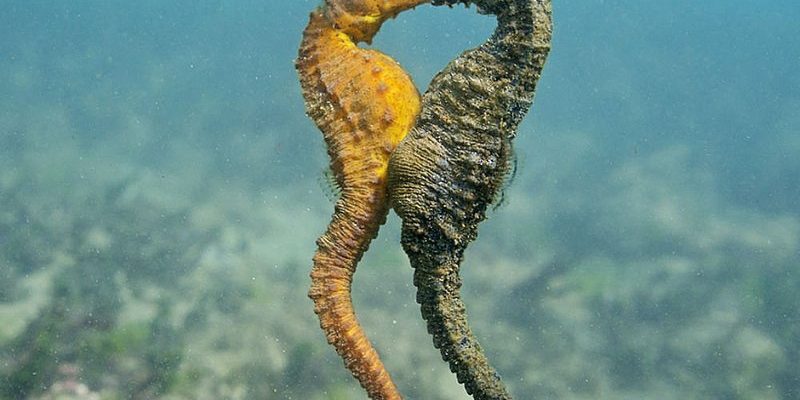
When we think about breeding and reproduction in the animal kingdom, we usually picture the male making elaborate displays to attract a female. But with seahorses, it’s a whole different ball game. Let me explain how these charming creatures go about forming families in their vibrant underwater habitats, from courtship to the miracle of birth.
Understanding Seahorse Behavior During Courtship
Seahorses kick off their breeding season with a marvelous dance. This courtship ritual is not just for show; it helps strengthen the bond between the pair. Turns out, they’re surprisingly monogamous for the breeding season, and some even stay together for life!
During this dance, the male and female seahorses twist around each other, changing colors and moving in sync. It’s almost like a choreographed ballet beneath the waves. This behavior not only attracts a mate but also helps them identify who they’re meant to be with. Isn’t that sweet?
Seahorses can spend several days or even weeks performing their courtship dance, which builds anticipation and trust. You might be wondering, “Why do they take so long?” Well, it’s all about making sure they are compatible partners who can create a safe environment for their future fry.
The Unique Role of Male Seahorses in Reproduction
Here’s where things get even more interesting. In most species, it’s the females who carry the young, but in seahorses, the males do the heavy lifting. Male seahorses have a dedicated brood pouch where they carry and nurture the fertilized eggs. This pouch acts like a protective chamber, providing oxygen and nutrients to the developing embryos.
When a female is ready to lay her eggs, she transfers them into the male’s pouch in a process called “egg transfer.” This can be quite a sight to see! The male then fertilizes the eggs and carries them for about 10 days to six weeks, depending on the species and environmental conditions.
During this time, the male may even have to adjust the pouch’s salinity to match the ocean water. Imagine him being like a mini oceanographer, ensuring the perfect environment for his little ones. It’s a major commitment!
The Gestation Period of Seahorse Fry
After the courtship and egg transfer, the waiting game begins. The gestation period for seahorses can seem surprisingly long, ranging anywhere from 10 days to six weeks, depending on the species and water temperature. This period is crucial as the embryos develop and mature inside the male’s pouch.
During this time, the male seahorse might exhibit various behaviors that show he’s ready for the big moment. You might catch him doing little jumps or having more pronounced breathing patterns. It’s like a nervous parent-to-be pacing back and forth before the birth.
When the fry are ready to be born, the male will go through a series of contractions, much like a human giving birth. It’s a remarkable process that showcases the unique nature of seahorse reproduction.
Birth: The Miracle of Seahorse Fry
When it’s time for the babies to emerge, the scene can be quite thrilling. The male seahorse starts experiencing contractions, and one by one, tiny seahorses start to swim out of his pouch. Depending on the species, he can release anywhere from 5 to over 1,000 baby seahorses in one go!
This moment is both exhilarating and vulnerable; those little fry are on their own from the start. They’re born miniature versions of adults, ready to swim away and fend for themselves in the vast ocean. It’s a harsh world out there—many won’t survive due to predators and environmental factors.
This independence is quite remarkable. The fry immediately start looking for their own food, often feasting on tiny crustaceans like copepods. It’s like they get thrown into the deep end of the pool, but they have everything they need to begin their journey.
Challenges Faced by Seahorse Fry
While the birth process is fascinating, the survival rate for seahorse fry is quite low. Many factors play a role in their early life, including predation, availability of food, and habitat loss.
In particular, young seahorses are vulnerable to a range of predators, from larger fish to sea birds. Their small size makes them an easy target, and many don’t make it past their first few weeks.
Furthermore, habitat destruction due to pollution and coastal development poses significant risks to seahorse populations. With their homes disappearing, these tiny creatures struggle to find safe places to grow and reproduce. It’s a concerning issue that highlights the need for conservation efforts.
Conservation Efforts for Seahorses
Given the unique breeding habits of seahorses and their vulnerability, there are growing conservation efforts to protect them. Many organizations are dedicated to raising awareness about the threats these creatures face and promoting sustainable practices to protect their habitats.
Aquariums and marine reserves are also playing a significant role in breeding programs. These programs aim to raise seahorses in controlled environments, ultimately releasing them back into the wild. It’s a way to improve their chances of survival while giving researchers valuable insights into their biology and behavior.
Community engagement is equally important. Coastal communities can help by participating in clean-up efforts and supporting sustainable fishing practices. When we all chip in, it makes a difference—especially for these enchanting little creatures.
In the end, the breeding and reproduction of the seahorse is a story of love, commitment, and survival. From the mesmerizing courtship dances to the unique way males nurture their young, there’s a lot to admire about these fascinating creatures.
While their journey from eggs to fry is filled with challenges, ongoing conservation efforts give hope for their future. By understanding how seahorses reproduce and the threats they face, we can take steps to protect their delicate world. Just like it takes a village to raise a child, it takes all of us to ensure that seahorses continue to thrive in our oceans for generations to come.

